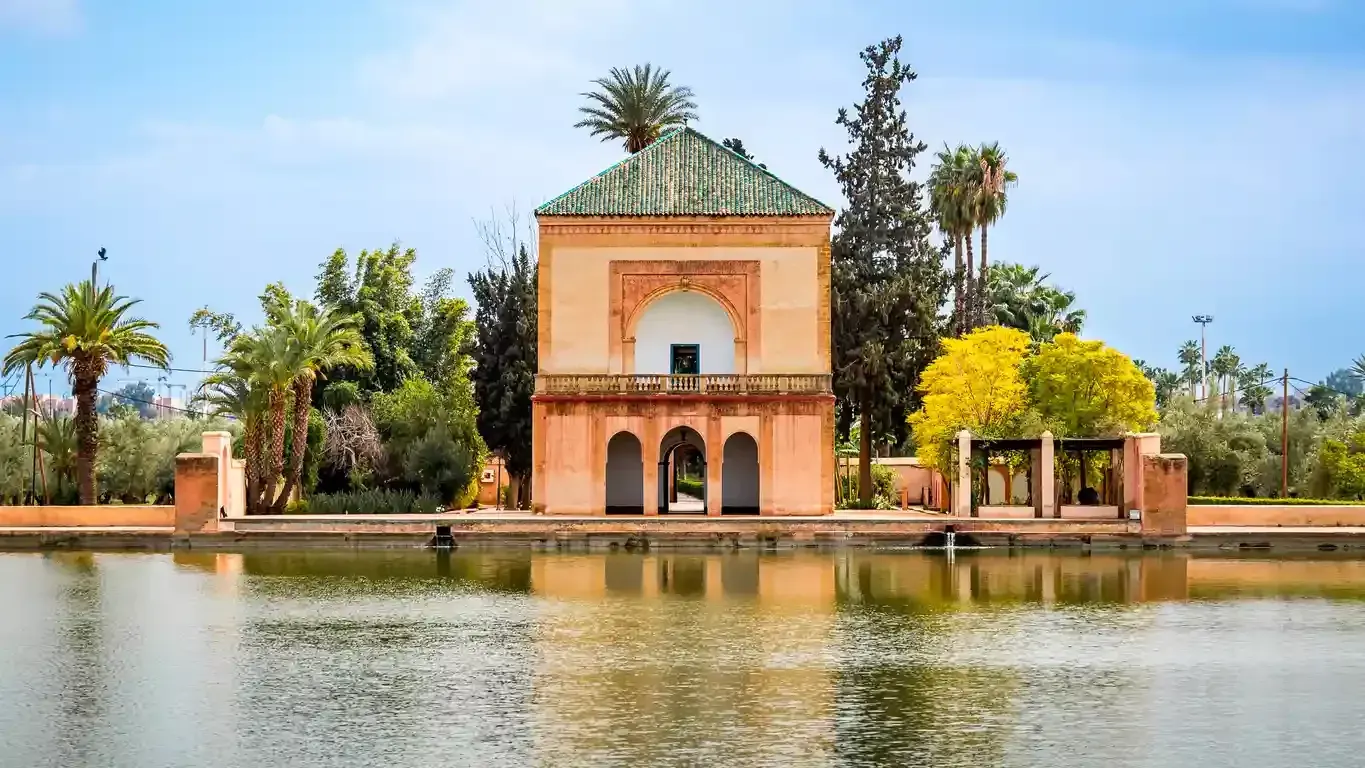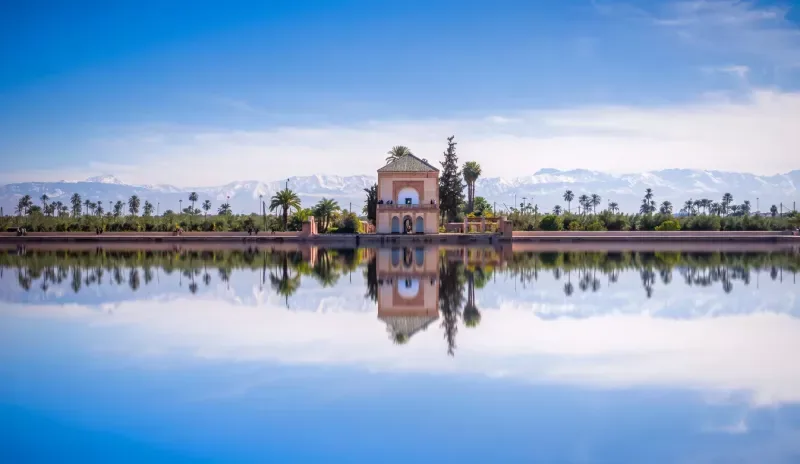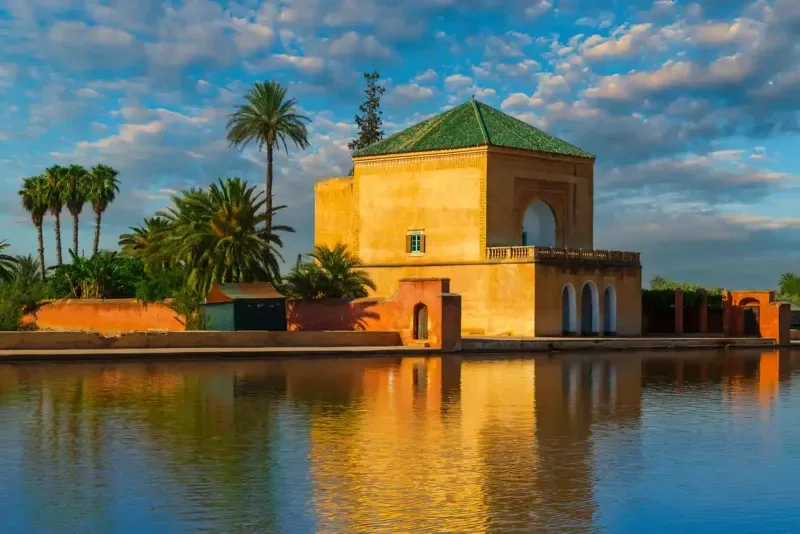Inside Menara Garden Marrakech: Ancient Olive Groves & Royal Tales
Menara Garden in Marrakech, Morocco, is a peaceful 12th-century landmark built by the Almohad dynasty. Surrounded by olive groves, a large reflective pool, and views of the Atlas Mountains, it offers a serene escape from the city. Perfect for strolls, photos, and cultural reflection, Menara Gardens beautifully embody Morocco’s harmony between nature and architecture.

Nine centuries ago, Almohad Caliphate ruler Abd al-Mu'min envisioned something extraordinary for Marrakech. His 12th-century creation would become one of the oldest gardens flourishing in the Muslim West, a testament to agricultural ingenuity that continues to captivate visitors today. This remarkable sanctuary has weathered the passage of time, remaining one of Marrakech's most cherished spaces where the relentless energy of city life gives way to profound tranquility.
Each footstep along these ancient pathways connects us to living history. The gardens earned recognition alongside the Agdal Gardens and historic walled city of Marrakesh, achieving UNESCO World Heritage Site status in 1985. Here lies the crown jewel of this horticultural marvel, a magnificent rectangular lake stretching 195 meters in length and 160 meters in width. This aquatic centerpiece owes its existence to an extraordinary feat of medieval engineering: a 30-kilometer network of channels that captures precious water from the distant Atlas Mountains.
The genius of this 12th-century hydraulic system becomes even more fascinating when we consider its endurance. The same channels that once supplied water for sultans gathering with their companions in the lakeside pavilion continue their ancient purpose today. The waters that once reflected royal conversations now mirror our modern wonderment, creating an unbroken chain between past and present that few places on earth can claim.
What Makes Menara Gardens Special
A peaceful escape from the Medina
Picture this: after hours navigating the sensory overload of Marrakech's medina, you discover an oasis where chaos transforms into calm. The expansive olive orchards function as nature's own cooling system, their ancient branches creating a canopy where dappled sunlight dances and Morocco's intense heat loses its edge. Water channels strategically positioned throughout the grounds produce a gentle symphony that drowns out the distant urban clamor, crafting an atmosphere of authentic tranquility.
This serene landscape operates on an entirely different rhythm than the medina's vibrant pandemonium. Spread across approximately 100 acres, these grounds offer abundant space for unhurried wandering, free from the shoulder-to-shoulder crowds that define the city center. The olive groves themselves become spontaneous sanctuaries where visitors discover pockets of genuine peace, each tree offering its own intimate gathering spot beneath centuries-old shade.
The iconic lake and Atlas Mountain backdrop
Geography bestowed upon Menara Gardens its most spectacular gift. The pavilion and reflecting pool create a perfectly framed foreground for what countless photographers consider Marrakech's most captivating vista. Winter and spring seasons reveal the gardens' true magnificence, when snow-crowned Atlas peaks emerge dramatically behind the verdant canopy, creating a breathtaking dialogue between cultivated paradise and untamed mountain wilderness.
Weather patterns dictate this natural theater's performance schedule. Crystal-clear atmospheric conditions unveil the mountains in their full splendor, while atmospheric haze can mute this spectacular backdrop. During sunset hours, the descending sun casts lengthy shadows across perfectly maintained pathways while bathing the water's surface in warm copper hues, creating moments that border on the otherworldly.
Why locals and tourists love it
Moroccan families have adopted Menara Gardens as their weekend refuge, especially during Friday and Saturday celebrations. These grounds transform into communal spaces where multiple generations gather to share traditional feasts—makooudas, pastelas, and fresh Moroccan bread beneath the protective canopy of ancient olive trees. University students particularly value these tranquil surroundings, finding them far superior to cramped urban accommodations for concentrated study.
International visitors arrive with diverse motivations, yet many describe their experience as "a serene escape from local chaos". The absence of entrance fees democratizes access, welcoming everyone from ambitious photographers seeking the perfect pavilion-and-mountain composition to families simply craving open space. Perhaps most remarkably, these gardens offer something increasingly rare: the chance to experience identical moments of peace that have refreshed Marrakech residents across nine centuries of continuous use.
Experience the serenity of Menara Gardens with our Morocco tour packages. Stroll through ancient olive groves, admire royal pavilions, and capture Marrakech’s timeless beauty!

Yes, Menara Garden is definitely worth visiting! I love its peaceful olive groves, mountain views, and the iconic reflecting pool, a must-see escape from Marrakech’s busy streets.
“Menara” means “lighthouse” or “minaret” in Arabic, symbolizing guidance and light, a fitting name for such a serene spot.
Exploring the Olive Groves
The layout and age of the trees
Menara Garden reveals its agricultural mastery through a vast olive plantation spanning approximately 100 hectares of precisely orchestrated landscape. The geometric perfection becomes immediately apparent as thousands of olive trees stand in flawless 10-meter intervals, creating a mesmerizing grid pattern that speaks to centuries of horticultural expertise. This methodical arrangement divides the plantation into roughly twenty-five rectangular parcels of varying dimensions, connected by 10-meter-wide earthen pathways that guide visitors through this living agricultural museum.
Botanical diversity flourishes within this ordered framework, showcasing about forty distinct olive varieties that represent Morocco's rich agricultural heritage. Some specimens have witnessed centuries pass beneath their gnarled branches, while newer plantings maintain the grove's vitality and productivity. The agricultural foundation established in the 12th century continues to define the garden's primary purpose, proving that beauty and function can coexist harmoniously.
Cultural significance of olive cultivation
Morocco's olive cultivation story began thousands of years ago, when the Phoenicians and Romans first brought these precious trees to North African soil. Abd al-Mu'min's vision for Menara Garden extended beyond mere beauty—he created an orchard and experimental agricultural laboratory, demonstrating how royal Moroccan gardens prioritized productive agriculture alongside aesthetic pleasure.
These groves represent far more than agricultural assets—they embody generations of inherited wisdom and cultural identity. Moroccan families treasure their olive trees as living heirlooms, passing down cultivation knowledge that connects past to present. Olive cultivation has woven itself into the fabric of Moroccan society, making these trees essential elements of daily existence and cultural expression.
Best times to walk through the groves
Optimal exploration of Menara's olive groves occurs during carefully chosen hours, early morning (8:00-10:00 AM) or late afternoon (4:00-6:00 PM) when temperatures remain comfortable and natural lighting creates enchanting conditions. These timing strategies prove particularly valuable given the limited shade available throughout the expansive plantation.
Spring months (March to May) and autumn (September to November) offer ideal climatic conditions for grove exploration, when mild weather encourages extended wandering among the ancient trees. Sunset hours transform the grove into something extraordinary as golden light filters through weathered branches and illuminates the adjacent water's surface.
Most visitors require approximately one hour to explore the entire grove, though the interspersed cypress and palm trees often inspire contemplative pauses. Weekend transformations reveal another dimension as local families claim shaded spots beneath venerable trees, creating vibrant picnic gatherings that continue traditions spanning generations.

I usually recommend spending about 1–2 hours at Menara Gardens to stroll, relax, and capture beautiful photos, especially during sunset.

The Pavilion and Its Stories
A look inside the Menara Pavilion
Majestic and serene, the Menara Pavilion commands attention from its position beside the shimmering waters. This architectural gem embodies classic royal Moroccan craftsmanship, crowned by its distinctive green pyramidal roof that has become synonymous with the gardens themselves. The structure measures precisely 12 meters on each side and soars approximately 14 meters skyward, a testament to 16th-century Saadian dynasty builders who conceived this enduring masterpiece. The pavilion's current appearance owes much to an 1869 restoration that gifted it the iconic green-tiled pyramidal roof we admire today.
Stepping inside reveals architectural wisdom that marries practicality with aesthetic grace. The ground floor opens through a triple-arched portico facing the lake, its spacious interior supported by four substantial pillars that have stood sentinel for centuries. A narrow staircase ascends to the upper chamber—a square room crowned by a rectangular balcony that frames panoramic vistas of the surrounding landscape. While the decoration appears understated compared to Morocco's more ornate monuments, closer inspection reveals exquisite details: ochre-painted motifs dance across walls, intricate wooden ceilings display master craftsmanship, and geometric stucco patterns tell stories of mathematical precision.
Legends of royal meetings and secret visits
Whispered tales have earned this structure an intriguing moniker, "The Pleasure Pavilion". Local storytellers speak of sultans who favored this secluded spot for private romantic rendezvous, away from the watchful eyes of court officials. The pavilion's architecture seems to encourage such speculation; the upper floor's unusually low rectangular door appears designed to shield interior activities from curious observers below.
Among the darker legends surrounding these waters, Sultan Moulay Ismail features prominently in local folklore. Stories describe his alleged practice of seducing women, strolling with them along the water's edge, then ending these encounters tragically in the lake's depths. Modern historians approach such tales with healthy skepticism, recognizing them as colorful embellishments that have accumulated over centuries to enhance the site's mysterious allure.
Photography tips and best angles
Photographers discover endless possibilities within this architectural treasure. The quintessential Menara image captures the pavilion's reflection dancing in the lake's surface while snow-capped Atlas peaks provide a dramatic backdrop—particularly breathtaking during winter and spring months when mountain summits wear crowns of white.
Golden hour photography transforms this location into something magical. Early morning and late afternoon light bathes the scene in warm amber tones, turning the water's surface into a mirror of liquid gold. The upper balcony serves photographers seeking interior perspectives, perfectly framing both the garden's methodical layout and distant cityscape views. Patient photographers who linger discover how shifting light throughout the day reveals subtle architectural details previously hidden in shadow.
Entry to Menara Gardens is free, making it one of Marrakech’s best budget-friendly attractions.
Customize Your Dream Vacation!
Get in touch with our local experts for an unforgettable journey.
Plan Your Trip
Tips for Visiting Menara Gardens Marrakech
Optimal timing for your garden experience
Strategic planning elevates any visit to these historic grounds beyond mere sightseeing. The golden windows of early morning (8:00-10:00 AM) and late afternoon (4:00-6:00 PM) deliver both comfortable temperatures and exceptional lighting conditions. Seasonal considerations prove equally important—spring months (March-May) and autumn (September-November) offer the most agreeable climate for thorough exploration. Weekend visits reveal vibrant family gatherings, while weekday excursions provide quieter contemplation of the gardens' ancient beauty.
Transportation options to reach the gardens
Three kilometers southwest of central Marrakech, the gardens await discovery through multiple routes. The 30-minute walk from Jemaa el-Fnaa along Houmane al Fatouaki Avenue offers street-level insights into local neighborhoods. Taxi services typically charge 50-60 dirhams from the city center, though fare negotiation beforehand prevents misunderstandings. Public transportation enthusiasts can utilize routes 11, 12, and 19, all stopping at garden entrances, with Line 19 Airport Shuttle maintaining 10-minute intervals. Those seeking memorable romance might consider the traditional horse-drawn carriage experience.
Strategic location advantages
The gardens' positioning creates excellent opportunities for efficient sightseeing. Marrakech Menara Airport sits merely 1.3 kilometers away, while Menara Mall requires only a 10-minute stroll. Ambitious visitors can easily incorporate Marrakech's New City of Gueliz (2.5 km), the towering Koutoubia Mosque (2.9 km), and bustling Jemaa el-Fnaa (3.4 km) into a comprehensive day itinerary.
Essential preparations and expectations
Daily operations span 8:00 AM to 7:00 PM with complimentary garden access. Wise visitors pack water, sunscreen, and sturdy walking shoes for extensive ground coverage. Food options remain limited to small shops offering beverages and packaged items. Traditional picnic preparations allow families to dine authentically beneath centuries-old olive branches. The pavilion charges a modest entrance fee ranging from 10-70 dirhams.

“Menara” means “lighthouse” or “minaret” in Arabic, symbolizing guidance and light, a fitting name for such a serene spot.
Conclusion
Standing at the edge of this ancient oasis, the profound realization strikes you—Menara Garden Marrakech represents far more than a simple tourist destination. This extraordinary sanctuary has achieved something remarkable: maintaining its original agricultural mission across nearly ten centuries while simultaneously offering visitors an authentic window into Morocco's soul. The olive groves continue their productive cycle just as Abd al-Mu'min intended, creating a rare harmony between preservation and purpose.
What captivates most deeply about this garden is its refusal to compromise historical integrity for modern convenience. The medieval irrigation channels still carry Atlas Mountain waters along their original routes, the olive trees follow their ancient geometric patterns, and the pavilion stands sentinel over waters that have reflected countless generations of Moroccan life. This authentic continuity creates an almost magical atmosphere where past and present merge seamlessly.
The garden's true genius lies in its democratic appeal. Moroccan families arrive with traditional feasts, international photographers seek that perfect Atlas Mountain backdrop, students find quiet study corners, and couples discover romantic sunset moments—all within the same sacred space that once hosted sultans and their companions. Such universal attraction speaks to something fundamental about human connection to peaceful, productive landscapes.
Consider the extraordinary privilege this represents: few places on Earth allow us to experience virtually unchanged medieval engineering still functioning at full capacity. The channels that once impressed 12th-century visitors continue their vital work, the olive varieties planted centuries ago still bear fruit, and the pavilion still frames the same breathtaking mountain vistas that captivated royal eyes.
This living museum offers visitors something increasingly rare: genuine tranquility earned through centuries of careful stewardship. Whether your passion lies in photography, agriculture, history, or simply finding respite from urban intensity, Menara Gardens delivers an experience that lingers long after departure. The garden's enduring appeal confirms a simple truth: some places possess a timeless quality that transcends mere beauty, touching something deeper in the human spirit.
FAQs
Q1. What is the historical significance of Menara Garden Marrakech?
Menara Garden Marrakech, established in the 12th century, is one of the oldest gardens in the Muslim West. It has been a UNESCO World Heritage Site since 1985 and features an impressive irrigation system that has been functioning for centuries.
Q2. What are the main attractions in Menara Garden?
The main attractions include the vast olive groves, a large rectangular lake, and a pavilion with a distinctive green pyramidal roof. The garden also offers stunning views of the Atlas Mountains, especially beautiful during sunset.
Q3. When is the best time to visit Menara Garden?
The best times to visit are early morning (8:00-10:00 AM) or late afternoon (4:00-6:00 PM) for pleasant temperatures and beautiful lighting. Spring (March-May) and autumn (September-November) offer ideal weather conditions for exploring the gardens.
Q4. Is there an entrance fee for Menara Garden?
Entry to the garden itself is free. However, there is a small fee (between 10-70 dirhams) to enter the pavilion.
Q5. What should visitors bring when visiting Menara Garden?
Visitors should bring water, sunscreen, and comfortable walking shoes. As there are no restaurants inside, many visitors choose to bring picnics to enjoy beneath the olive trees.
Menara Gardens is famous for its large reflective pool, olive trees, and stunning views of the Atlas Mountains, creating a picture-perfect oasis.



































